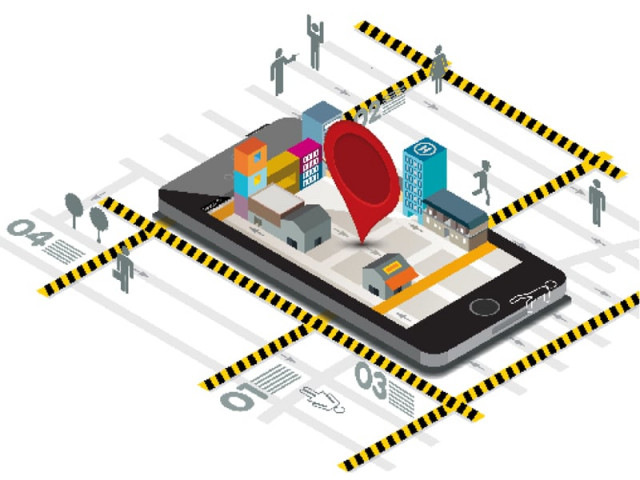Smart policing: Police learn to use digital mapping to tackle crime
Phones loaded with app developed locally handed to each police station.

Phones loaded with app developed locally handed to each police station.
The city police’s investigation wing has launched a mapping programme to identify the most dangerous areas and work out how to tackle crime there.
Police officials have been given smartphones loaded with an application designed by the Punjab Information Technology Board (PITB) and taught how to use it to map incidents of crime. The board has handed out a total of 83 phones, one to each police station.
Crime Records Office SP Mustafa Hameed Malik told The Express Tribune that three or four Police Record and Office Management Information System (Promis) personnel at each station had been taught to use the smartphone app.
The app allows policemen to enter the FIR number, date of occurrence, time, description and area of jurisdiction for each crime, as well as pictures of the crime scene and the complainant, and mark it on a Google map of Lahore using the GPS in the phone. The data is stored directly to the PITB database web server in real time, currently accessible only to the Investigations DIG and the CRO SP, police sources said.
A source at the PITB said that the main database server shows Google maps marked with the crime data sent from the field by police personnel on their smartphones. A satellite view from 300 metres above ground level shows the place and name of the crime committed. A bubble appears at the spot, upon clicking which the user can see the data entered about the crime and the pictures.

Crimes can be viewed on the map separately or collectively. “The proximity of different crimes in particular areas helps police understand crime trends better, and thus helps devise appropriate strategies to fight them,” said Investigations DIG Zulfiqar Hameed.
He said that the crime mapping was “the first step towards smart policing. It will reduce the crime rate in the city to an extent that will be felt by everyone within six or seven months.”
The training of policemen for the project began on July 31 and 2,500 cases have been marked on the crime map since then. The PITB sources said that personnel at 15 of the 83 police stations in the city had yet to start mapping crimes due to technical problems.
The 83 phones provided to the police came from the PITB, as the Punjab government has not yet approved funds for the project. The PITB sources said that the phones were given to the board by the Punjab government during the elections in order to gauge voting trends.
“As soon as the government approves the PC-1 for the crime mapping project, the PITB will be returned the phones,” said the DIG.
The PC-1, seeking some Rs180 million for the project, has been prepared by the Lahore police and sent to the Planning Commission for approval, he said. Both the chief minister of the Punjab and the prime minister have applauded the project, he added.
Hotspots
The DIG said that incidents of crime were not spread evenly on the map. Clusters he called hotspots accounted for a disproportionate number of crimes.
“The appeal of focusing limited resources on a small number of high crime activity places is straightforward. If we can prevent crime at hotspot locations, then we might be able to reduce total crime,” he said. “Hotspot policing is a big plank of smart policing.” The mapping would allow police to deal with crime “surgically” and would end random patrols, Hameed said. Recent research showed that focused police interventions, such as directed patrols, proactive arrests, and problem-oriented policing were far more effective than random patrolling and picketing, he added.
Hameed said that the new smart policing policy was based on CompStat (comparative statistics or computer statistics), a police management and accountability system originally developed by the New York Police Department and now in use in most of North America.
The model seeks to focus police organisations on specific problems and empower them to identify and solve them. “Given the growing popularity of this approach to crime prevention across the world, it can help executives and policymakers understand what works in preventing crime in hot spot areas,” he said.
SP Mustafa Malik said that a pilot project at four police stations had had positive results. It showed that Gulshan-i-Iqbal Park alone accounted for six per cent of car theft in Lahore.
“Just by focusing on that particular hotspot, we managed to reduce the rate of car theft in the city. Foot patrols followed by patrol maintenance resulted in significant reductions in calls for service. The enforcement of a problem-oriented policing strategy also resulted in significant reductions in total crime incidents, and varying reductions in all subcategories of crime types,” he said.
He added that extra policemen would be deployed in the 10 areas with the most crimes.
Crimes Investigation Agency SP Umer Virk said that the project would have great practical use. “Police officers know the locations in their beats that tend to be trouble spots and are often very sensitive to the signs of potential crimes across their beats. Pinning crime activities on digital maps with dates, times and exact locations will enhance police performance.”
Published in The Express Tribune, August 18th, 2013.



















COMMENTS
Comments are moderated and generally will be posted if they are on-topic and not abusive.
For more information, please see our Comments FAQ